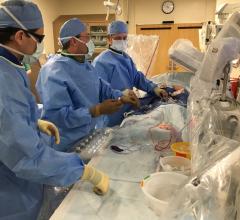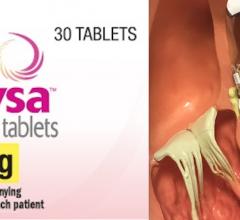
Alere's INRatio PT/INR monitoring system with test strip inserted.
Anticoagulants, primarily warfarin, are used to prevent thrombosis and thromboembolism in patients with atrial fibrillation, artificial heart valves, deep venous thrombosis (DVT) and pulmonary embolism. However, warfarin has a narrow therapeutic window and interacts with other medications and some foods, mainly fresh green vegetables rich in vitamin K. To ensure the drug remains at effective therapeutic levels while balancing bleeding issues associated with higher doses, patient require regular blood testing.
Over the past decade there have been several advancements in prothrombin time (PT)/international normalized ration (INR) point-of-care testing (POCT) devices. This is usually performed at an outpatient Coumadin clinic or at the physician’s office, which can be inconvenient for patients, so there is a growing trend toward patient self-testing (PST) devices.
Alere’s INRatio System
Alere offers the Alere INRatio/INRatio2 PT/INR monitoring system for POCT or PST. The device can work off plug or battery power. It requires a 15µL drop of blood and yields results in about 60 seconds. Each test strip offers its own quality control and is individually wrapped. The device strips run high and low ranges up to 7. If higher, the device will state an error.
For PST, patients are provided a 24/7 number to phone in results, or they can enter the results online if their physician leases software. It is recommended patients call or key in results during business hours for better disease management, but Alere also offers after hours contact instructions.
For patients, Medicare may cover up to 80 percent of device and strip costs, and secondary insurance can be used to cover extra costs.
For POCT, physicians can connect the device to a computer with PC Connect Software for INR result downloading. Also physicians can choose to print to the Alere INRatio Printer (at an extra cost). Alere also offers its Standing Stone Software, which automatically faxes results to physician, offers a Web-based population of results, enables once-a-month faxes of in-range patients or daily faxed reports. The software is customizable.
Standing Stone offers date management and the ability to deposit patient results into in-office EMR (electronic medical records). It also detects patient medication drug-drug interactions and keeps track of patients dosing algorithms. It can customize patient questions for anticoagulation treatment. The software also provides Medicare billing reports for physician result interpretation.
Alere offers training by certified nurses for patients in-home, or will train staff at clinic. Alere can also be an intermediary to charge insurances for training. Even if insurance won’t reimburse clinic for training, Alere will train clinic at no cost. Overall, Alere offers a “one stop shop for anticoagulation management,” with an easy-to-read display, a built-in memory to store INR results, and a battery that supports 200 INR tests.
Future advancements: Piloting wireless technology, piloting Bluetooth, working on advanced testing strips that will require less blood.
Philips INR Self-Testing Service
Using the Alere INRatio/INRatio2 PT/INR monitoring system, Philips offers the software to take this device to the next level. Philips offers a three-component model that supports patient in-home and clinic staff training by Philips Lifeline-trained technicians. It includes technical support and software for physician interpretation of results. With the service, patients can receive not only receive a meter, but they receive strips at no extra cost.
Medicare covers Philips’ service. Philips also calls Medicare for device reimbursement and contacts the patient when the device is ready.
Physicians are given reports with graphs via fax. When patient’s results are out of range, they are asked to re-test by Philips. Currently, Philips only offers patients the ability to call in results. If patients have any device issues, they can dial to speak to someone at Philips technical support and can also order supplies over the phone.
Roche’s CoaguChek XS System for Patient Self-Testing
Designed for testing by professionals or patients, the Roche CoaguChek XS system reports in a range of 0.8 to 8, and only requires an 8 µL drop of blood. For patients, it offers a Web-based platform with tutorials on how to test, enter new results online, order supplies, access patient protected information, update their patient profile and how to handle insurance information. The system can be accessed by managing clinics as well.
Patients cannot report results outside business hours (8 a.m. to 8 p.m. EST, Monday thru Friday), or on holidays. The CoaguCheck Link system does not allow patients to order supplies if they are not current on test results, and it only allows supply ordering when needed. It generates personal results and a chart for patients, and offers a schedule of when to test. For those who prefer to call in results, Roche provides call in results, ordering and the ability to talk to an operator. The system monitors adherence by having a three-strike system of noncompliance, which requires a new prescription for further testing. Roche offers clinic in-office training for staff and in-home patient training.
If a patient falls out of range they will receive a call and a referral to a clinic or hospital.
For healthcare providers, CoaguCheck Link offers a real-time list of patients called and if they are in range or not. Providers receive online updates every three minutes.
Roche has clinical staff with medical certificates that send out reports and contact patients. However, dosing is only adjusted by the patient’s physician. Physicians receive e-mails if results have not been checked recently and receive a faxed report. Physician can modify ranges per patient and can also enter results taken at clinic.
The software allows for billing every four weeks to Medicare, insurance and the patient for interpretation of results.
Point-of-Care CoaguSense Monitoring System
The handheld, portable CoaguSense device requires a 10 µL drop of blood and tests INR ranges of 0.8 to 8. Each test strip has a barcode, which conveys calibration and control range information. Training is provided with instrument purchase. A patient self-testing program is available.
The system measures the actual time required for clotting and directly detects the clotting endpoint. It uses the tilt-tube method with fresh capillary whole blood, venous or recalcified plasma samples. It displays PT results in less than one minute.
The CoaguSense PT/INR monitoring system is now cleared by the U.S. Food and Drug Administration (FDA) for use by patients in home by prescription.
Medical professionals can order the system through Abbott Point of Care, which formed an exclusive agreement with CoaguSense to sell and market the CoaguSense PT/INR Monitoring System.
No test strip refrigeration is required and there are no electrodes to clean. An enclosed detection wheel in each strip eliminates cross contamination risk. The device is AC or battery powered. Abbott also provides 24/7 technical support.
Unlike electrochemical detection-based devices, the CoaguSense system does not rely on the concentration of blood constituents not involved in clot formation to produce results. The vendor says this improves precision and reduces variability in readings sometimes seen in other systems.
Because the CoaguSense system uses a micromechanical means of clot detection instead of electrochemical, re-calcified plasma control strips can be run as easily as whole blood. This also means that the CoaguSense system is not affected by low hemoglobin or hematocrit levels, a common source of inaccurate results in systems using current to detect clot formation.
To reduce strip waste caused by unsteady hands, the sample is easily transferred from the patient's finger to the test strip using the minipipette or sample transfer tubes provided with the strips.
At-Home Care
All these devices can be released to a patient for home use after in-office training or at-home training. Home testing helps empower patients and offer the flexibility of not having to go to a clinic for testing. Medicare covers the cost for testing up to four times a month on most devices. Medicaid covers devices in certain states.
A big advantage of home testing is the ability of adjusting therapy much sooner than if a patient waited for a clinic appointment. This allows physicians to make prompt medication changes and facilitate discussion of dosage changes with patients. This leads to increased time in therapeutic range and may improve clinical outcomes with reductions in thromboembolic and hemorrhagic events.
Home testing also helps maximize practice efficiency by reducing time-consuming patient callbacks.
Medicare Eligibility
Patients must have been anticoagulated for three months prior to use of a home INR device. They must undergo a face-to-face educational program on anticoagulation self-management and must have demonstrated the correct use of the device prior to its use in the home. Self-testing with the devices should not occur more frequently than once a week.
With point-of-care testing, the devices are typically more expensive per unit cost, but the cost of operation is less expensive. Patient self-testing systems place the burden of cost on the patient to either pay out-of-pocket or support with insurance approval.
Read the 2017 article "Advances in Point-of-Care Coagulation Analyzer Technology."
Editor’s note: Marianne Pop, Pharm.D., BCPS, is a clinical pharmacist and clinical assistant professor with the regional pharmacy program, University of Illinois at Chicago College of Pharmacy. She specializes in emergency medicine pharmacy as part of the regional pharmacy program at OSF Saint Anthony Medical Center in Rockford, Ill.




 August 28, 2023
August 28, 2023 








